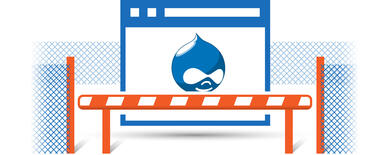
Phrases That You Need to Understand When Talking to a Drupal Developer: Node
Drupal is an increasingly popular CMS used to build company websites. There is an increasing chance that you will come across this system in your work and your task will be to discuss building a new website or expanding the existing one. In this series of articles, you will learn the most frequently appearing phrases, i.e. keywords referring to the websites built using Drupal. Read it and become better prepared for such a conversation.
Who is a Drupal developer?
A Drupal developer is a programmer who knows PHP language and has experience in creating dedicated modules for Drupal. He can also navigate efficiently within the system's administration panel and create templates for Drupal. Is a person who changes business requirements into new functionalities in a system built using Drupal.
Who might need to have a talk with a Drupal developer?
At Droptica we build many different types of websites. In every case, we deal with people from various departments in our clients' companies.
For example, we talk with marketing representatives – because it is the marketing that usually guides the development of a company website.
People from the IT department may also be involved because we often integrate Drupal with the systems already existing in the company.
The HR team often wants to publish job offers on the company website, which is why they also tend to participate in meetings with programmers.
In manufacturing companies, the people responsible for creating the products want to ensure that their products are presented to potential clients in the best possible way. For this reason, they take part in the development of the website.
Therefore, as you can see, virtually every department in any company may be interested in developing certain elements on the company website.
The most commonly used phrases related to Drupal
This article is just the first one in a series. You will learn the first phrase from it.
If the phrases below are clear to you, then let some other people in the company take a look at it to make Drupal more understandable to them.
Node & Node/Content Types
A node is one article or one subpage. I could actually end this short explanation here.
However, a Node in Drupal is more than just an article or subpage from other CMSs.
Node is one of the entity types (later in the article I will explain what an entity is), whose structure can be expanded using the administration panel without the need of coding.
What expansion exactly is this about?
In order to add a new subpage in a CMS, you must find the appropriate form in the administrative panel. When creating a simple subpage, this form should consist of two fields:
- page title – a field with one line
- page content – a field with many lines, usually with a WYSIWYG editor, e.g. CKEDITOR.
Such a structure (title + content) will be sufficient for small pages, but medium- and large-sized pages often require more structured information.
As a website editor, you probably want different ways of displaying news, products and services and job offers. You can do it using a simple field with content, but it is not convenient and does not work very well if you have more than a dozen or so subpages.
Exactly in such a case, you can use the Drupal's extensive capabilities as a CMS.
In Drupal, you can first define the types of content (Node types or Content types), e.g. article, product, job offer, advertisement, institution address, person (e.g. sales representative or specialist), etc. Then you can build a separate data structure for each one of these types.
For example, an Article may have the following fields in the form:
- Title;
- Introduction;
- Content;
- Main photo;
- Category.
A job offer may have the following fields in the form:
- Position name;
- Duties description;
- Requirements;
- Location;
- Remuneration;
- Number of vacancies.
Going back to the word "Node" – that is, to the content – it is a single entry in the system that has a specific type. For example, the entry you are reading right now is a Blog Node.
The number of content types in a system can be infinite, e.g. blog, product, services, job offers. The number of content sections of a given type in a system can be infinite also.
If you want to have within a Drupal-based system a new content type with a specific structure of the content adding form, then talk to the Drupal developer about the new type of content (Content Type, Node Type).
In some text descriptions, aimed rather at programmers, you can also find the phrase "Node Bundle". This is the same as "Node Type" or "Content Type" – i.e. a separate type of data structure.
Summary
In the next articles, I will describe what the phrases such as Field, Block, Region, Module, Taxonomy, Paragraphs and Entity mean in Drupal.
I hope that after reading this text you will understand the world of Drupal better and that the implementation of tasks you entrust to the drupal Developers will be much more efficient.












